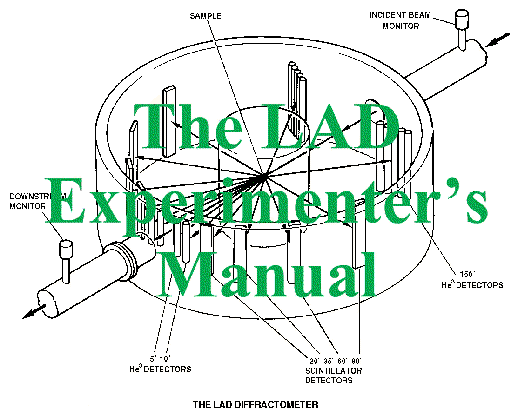
| 7.2 Bragg Peaks |
![]()
For an experiment on a liquid or an amorphous sample the presence of crystalline Bragg peaks in the diffraction pattern is most unwelcome since it is not easy to subsequently remove them from the data. Hence if Bragg peaks are observed in the data during the experiment it is well worth identifying their cause and removing it if possible. The cause of the Bragg peaks may be a piece of sample environment equipment or sample mount which can be rearranged to be out of the neutron beam. Alternatively the Bragg peaks may be due to impurities in the sample which can be removed.
A simple program is available for calculating the Bragg peak positions for simple crystal structures. The program is run by typing RUN G_F:BRAGG . The results may be either written to the terminal or to a file of extension .BRAGG . The results are sorted into order of descending d-spacing. The program calculates the positions of the Bragg peaks (d-spacing, Q-value and scattering angle 2q ) for either a cubic system or for a hexagonal close packed (hcp) system. In the case of a cubic system the program indicates which of the calculated reflections are actually allowed for body-centred cubic (bcc) and for face-centred cubic (fcc). The program prompts the user to give a wavelength in order that the scattering angle 2q can be calculated for a fixed wavelength experimental setup (e.g. a neutron diffractometer on a reactor source or an X-ray set). If the user is not interested in the 2q values (i.e. if the calculation is to be used for comparison with time-of-flight data) then the suggested procedure is to accept the default wavelength of 1.0 by pressing carriage return. An example of running the program BRAGG for hcp zirconium (a=3.2312Å and c=5.1477Å) follows:
LAD>run g_f:bragg
***************************************************************
* BRAGG : Calculate d-spacings of simple structures *
* Alex Hannon 11-2-92 *
***************************************************************Give lambda [1.0] >
Options...
1) Cubic (sc,bcc,&fcc)
2) hcp
Give option > 2
Give lattice parameters a,c > 3.2312 5.1477
Give minimum d-spacing of interest dmin > 1.1
Give name of output .BRAGG file or CR for output to terminal >
a = 3.231200 c = 5.147700 lambda = 1.000000hkl=100 n = 0 d = 2.7983 Q = 2.2454 2thet = 20.59
hkl=002 n = 0 d = 2.5738 Q = 2.4412 2thet = 22.40
hkl=101 n = 0 d = 2.4585 Q = 2.5557 2thet = 23.47
hkl=102 n = 0 d = 1.8944 Q = 3.3168 2thet = 30.61
hkl=110 n = 0 d = 1.6156 Q = 3.8891 2thet = 36.06
hkl=103 n = 0 d = 1.4628 Q = 4.2953 2thet = 39.97
hkl=200 n = 0 d = 1.3992 Q = 4.4907 2thet = 41.88
hkl=112 n = 0 d = 1.3684 Q = 4.5917 2thet = 42.86
hkl=201 n = 0 d = 1.3502 Q = 4.6536 2thet = 43.47
hkl=004 n = 0 d = 1.2869 Q = 4.8823 2thet = 45.73
hkl=202 n = 0 d = 1.2293 Q = 5.1113 2thet = 48.00
hkl=104 n = 0 d = 1.1692 Q = 5.3739 2thet = 50.64
FORTRAN STOP
LAD>
For crystal structures which are more complicated than simple cubic (sc), bcc, fcc or hcp the reflections may be calculated by first setting up a .CCL file as for profile refinement and then running the TIC program by the command @HRPD$DISK:[HRPMGR.CCSL.COMMAND]TIC .
The results of the program BRAGG, stored in a .BRAGG file, may be read into a GENIE workspace by use of the command @G_F:BRAGGIN . The contents of the workspace may then be plotted on top of experimental data by use of the GENIE command P/T ymin ymax (Plot Tickmarks). As an example Figure 6 shows a comparison between the calculated Bragg peaks of hcp zirconium and data taken on LAD for a nominally pure sample of zirconium which actually contains an impurity crystalline phase. (The experimental data shown in Figure 6 were analysed using the program ND described in section 4.4).
Please note that sections 8.2 and 8.3 of this manual give the d-spacing formulae for simple crystal systems and also the crystal structures of some metallic elements.
![]()
![]()
Last Updated 09 Nov 1998